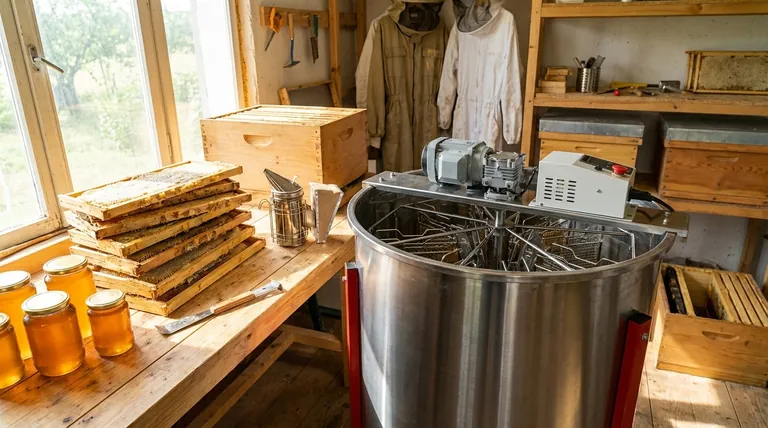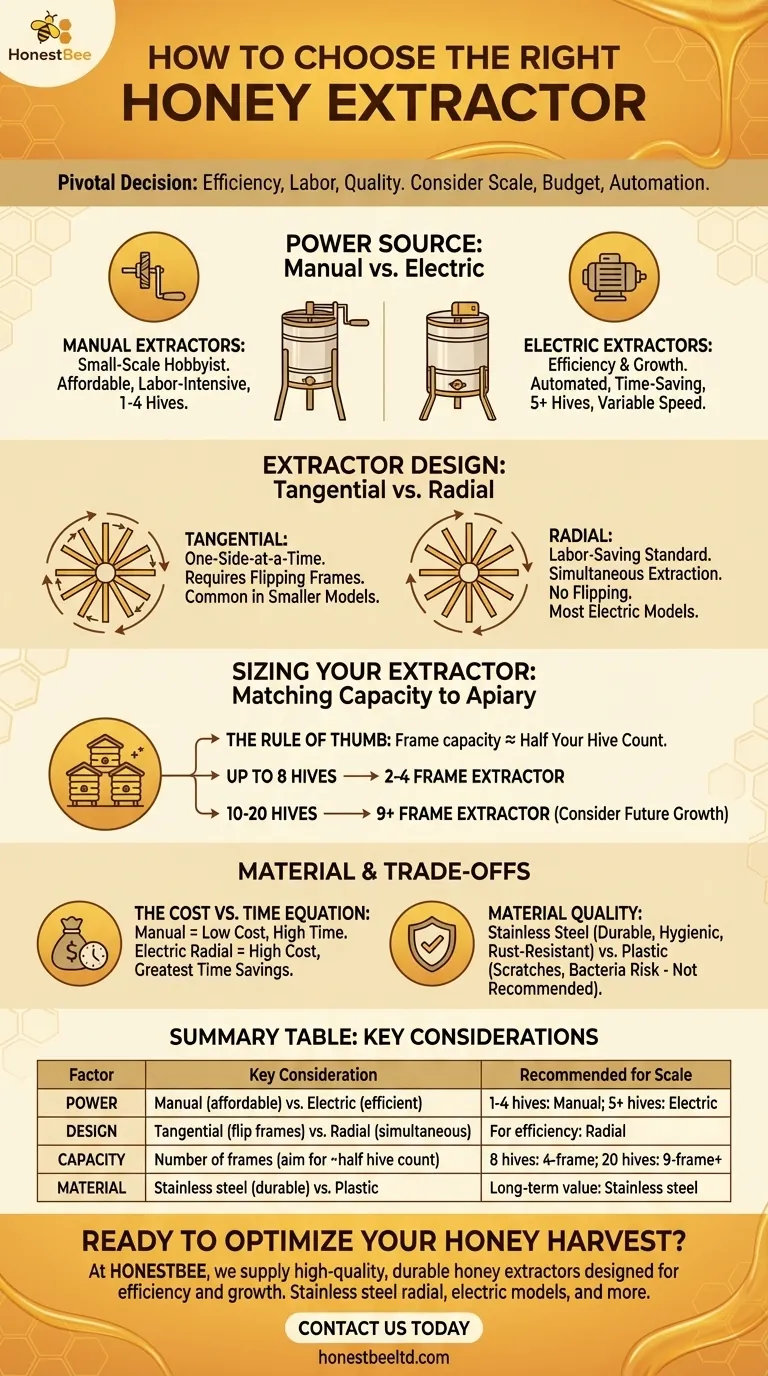Choosing the right honey extractor is a pivotal decision for any beekeeper, directly impacting your efficiency, labor, and the quality of your harvest. Your choice should be guided by three core factors: the scale of your operation (number of hives), your budget, and the trade-off between manual labor and automated efficiency. For most, a durable stainless steel model is the superior choice for longevity and food safety.
A honey extractor is more than a piece of equipment; it's an investment in your time. The central challenge isn't just buying a machine that works today, but selecting one that aligns with your current scale while intelligently anticipating your future growth.

The First Critical Decision: Manual vs. Electric Power
Your first consideration is the power source. This single choice has the largest impact on your cost, time commitment, and the physical effort required during harvest.
Manual Extractors: For the Small-Scale Hobbyist
Manual, hand-crank extractors are the entry point for many beekeepers. They are the most affordable option and work perfectly well for those with a small number of hives.
The hands-on nature can be appealing, connecting you directly to the process. However, the labor involved can be significant, especially as your apiary grows beyond a few hives.
Electric Extractors: For Efficiency and Growth
Electric extractors automate the spinning process, saving a tremendous amount of labor and time. They are the standard for any beekeeper prioritizing efficiency or managing more than 4-5 hives.
These models often include variable speed controls, which allow for a gentle start to prevent blowing out delicate foundation wax, followed by a faster spin for full extraction. While more expensive, the return on investment is measured in hours saved.
Understanding Extractor Design: Tangential vs. Radial
The way an extractor holds the frames determines its efficiency. This is a technical distinction that has major practical consequences.
Tangential Extractors: The One-Side-at-a-Time Method
In a tangential extractor, frames are placed like spokes in a wheel, with one side of the comb facing outward. Centrifugal force extracts honey from only this outer side.
You must then stop the machine, manually flip each frame, and spin again to extract honey from the other side. This design is common in smaller, less expensive manual models.
Radial Extractors: The Labor-Saving Standard
In a radial extractor, frames are positioned with the top bar facing the outer wall. Centrifugal force acts on both sides of the comb simultaneously.
This design is significantly more efficient as it eliminates the need to flip frames, nearly halving the labor and time required. Most electric extractors intended for serious hobbyists or commercial use are radial.
Sizing Your Extractor: Matching Capacity to Your Apiary
The "size" of an extractor is defined by the number of frames it can hold at once. Choosing the right capacity is a balance between your current needs and future ambitions.
The Rule of Thumb: Hives vs. Frames
A practical guideline is to choose an extractor with a frame capacity that is roughly half the number of hives you manage.
For example, a 2- or 4-frame extractor is generally sufficient for an apiary of up to 8 hives. A beekeeper with 10-20 hives should seriously consider a 9-frame extractor or larger to make harvest manageable.
Planning for Future Growth
It is often wise to invest in an extractor that is slightly larger than your immediate needs. Outgrowing a small extractor is a common frustration that forces a second, more expensive purchase later.
Understanding the Trade-offs
Every design choice involves a compromise. Being aware of these trade-offs is key to making a decision you won't regret.
The Cost vs. Time Equation
A manual extractor is the cheapest upfront but demands the most time and physical effort. An electric radial extractor is the most expensive but offers the greatest time savings. Your budget and the value you place on your own labor are the deciding factors here.
Material Quality: The Hidden Cost of "Cheap"
While plastic extractors are available and inexpensive, they are not recommended for serious use. Plastic can scratch easily, creating crevices that harbor bacteria and are difficult to sanitize. Food-grade stainless steel is the industry standard for its durability, rust resistance, and hygienic properties.
Key Construction Features to Look For
Beyond the core type, look for signs of quality construction. A stable base with wide-set legs prevents wobbling, a clear lid allows you to monitor progress, and a high-quality, welded honey gate ensures a leak-free drain.
Making the Right Choice for Your Goal
Filter your decision through the lens of your primary objective as a beekeeper.
- If your primary focus is keeping 1-4 hives as a hobby: A 2- or 4-frame manual tangential extractor in stainless steel is your most cost-effective and practical starting point.
- If your primary focus is efficiency for 5-20 hives: An electric radial extractor with a capacity of 9+ frames is a wise investment that will save you countless hours of labor.
- If your primary focus is long-term value and food safety: Prioritize a welded, food-grade stainless steel body and components, regardless of size or power type.
Ultimately, the right extractor empowers you to harvest your honey cleanly and efficiently, turning a potentially arduous task into a rewarding part of your beekeeping journey.
Summary Table:
| Factor | Key Consideration | Recommended for Scale |
|---|---|---|
| Power Source | Manual (affordable, labor-intensive) vs. Electric (efficient, time-saving) | 1-4 hives: Manual; 5+ hives: Electric |
| Design | Tangential (flip frames) vs. Radial (simultaneous extraction) | For efficiency: Radial |
| Capacity | Number of frames (aim for ~half your hive count) | 8 hives: 4-frame; 20 hives: 9-frame+ |
| Material | Stainless steel (durable, hygienic) vs. Plastic (less recommended) | Long-term value: Stainless steel |
Ready to optimize your honey harvest? At HONESTBEE, we supply commercial apiaries and beekeeping equipment distributors with high-quality, durable honey extractors designed for efficiency and growth. Our wholesale-focused operations ensure you get the best value on stainless steel radial extractors, electric models, and more. Contact us today (#ContactForm) to discuss how our equipment can save you time, reduce labor, and scale with your operation.
Visual Guide

Related Products
- 8-Frame Electric Self-Reversing Honey Extractor Spinner for Commercial Honey Extraction Equipment
- HONESTBEE 6 Frame Three Use Electric Honey Extractor for Beekeeping
- HONESTBEE 3-Frame Manual Acrylic Honey Extractor
- HONESTBEE 72 Frame Industrial Electric Honey Extractor for Beekeeping
- Commercial Electric 12 Frame Honey Extractor Spinner Motorized Honey Extractor
People Also Ask
- What are the benefits of using a honey extractor? Maximize Harvest & Save Bee Energy
- What are the size and power variations in honey extractors? Optimize Your Harvesting Efficiency
- Why is preserving honeycomb integrity important, and how do automated extractors help? Boost Hive Health & Honey Yields
- What is a honey extractor and how does it benefit beekeepers? Boost Honey Yield & Hive Health
- What should a beekeeper do after extracting honey from supers? A Guide to Harvest Management



















